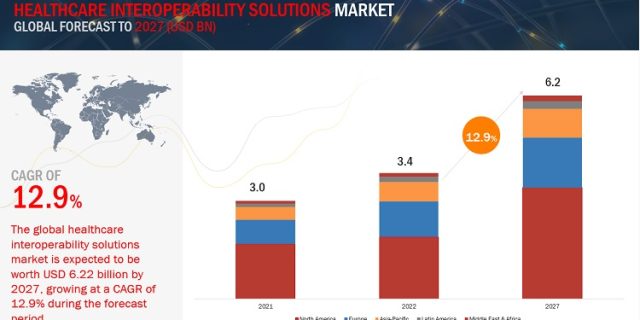
Growth in Healthcare Interoperability Solutions Market is driven by the increasing demand for efficient and cost-effictive healthcare delivery, government initiatives towards improving the healthcare interoperability. However, the lack of true interoperability among electric systems, financial burden and technical difficulties in building and operations are some factors restraining the growth of the healthcare interoperability solutions market to a certain extent during the forecast period. The base year considered for the study is 2021, while, the forecast period is 2022 to 2027.
The report Healthcare Interoperability Solutions Market is projected to reach USD 6.2 billion by 2027 from USD 3.4 billion in 2022, at a CAGR of 12.9% during the forecast period.
Download PDF Brochure: – https://www.marketsandmarkets.com/pdfdownloadNew.asp?id=17705847
KEY MARKET DYNAMICS
1 DRIVERS
1.1 Increasing demand for efficient and cost-effective healthcare delivery
1.2 Government initiatives and regulations to enhance patient care and safety
1.3 Emergence of new medical technologies
1.4 Growing adoption of electronic health records
2 RESTRAINTS
2.1 Lack of accurate interoperability solutions across healthcare supply chain
2.2 Lack of standards and protocols in IT businesses
2.3 Use of outdated legacy systems in hospitals and clinic chains
3 OPPORTUNITIES
3.1 Growing markets for healthcare interoperability solutions in developing countries
3.2 Advancements in software technology for real-time data exchange
4 CHALLENGES
4.1 Increasing complexity due to lack of consistent data
4.2 Shortage of skilled healthcare IT professionals
4.3 Patient data security and privacy concerns in healthcare industry
Market Segmentation:
- On the basis of type: the services segment accounted for the largest share. The large share of this segment can be attributed to the advantages offered by the services such as installation, equipment updates or traditional licensing management are not required in case of services.
- Based on end user: the healthcare providers segment is expected to register the highest CAGR during the forecast period. The growing geriatric population leading to the increasing hospital admissions is contributing to the growth of this segment.
Regional Analysis:
North America accounted for the largest share of the healthcare interoperability solutions market in 2021, followed by Europe and Asia Pacific. The rising demand for value-based healthcare, the need to reduce the increasing healthcare costs, and the implementation of favorable government initiatives & regulations in the region are the key factors responsible for the large share of North America in the healthcare interoperability solutions market.
Recent Developments
- In November 2022, Nextge Healthcare (US) acquired TSI Healthcare (US) to expand its presence in key specialties, including rheumatology, pulmonology, and cardiology.
- In October 2022, Lyniate (US) partnered with CyncHealth (US) to help healthcare providers and health networks, payers, and public health departments power more meaningful data exchange.
- In September 2022, Lyniate (US) partnered with BrightInsight (US) to improve Information Exchange for Regulated Digital Health Solutions Built on the BrightInsight Platform.
- In July 2022, Intersystem Corporation (US) partnered with Bedfordshire Hospitals NHS Foundation Trust to develop a new shared health and care record, which is being rolled out across Bedfordshire and Luton.
Request Sample Pages: – https://www.marketsandmarkets.com/requestsampleNew.asp?id=17705847
Top Key Players: –
Some of the prominent players in this market are Cerner Corporation (US), Epic Systems Corporation (US), Infor, Inc. (US), Koninklijke Philips NV (Netherlands), InterSystems Corporation (US), Orion Health Group Limited (New Zealand), IBM Watson Health (US), Lyniate (US), Change Healthcare (US), NextGen Healthcare, Inc. (US), and Medical Information Technology, Inc. (US), iNTERFACEWARE (Canada), OSP Labs (US), ViSolve, Inc. (US), Jitterbit (US), Virtusa Corp. (US), and Summit Healthcare Services, Inc. (US).
Conclusion: –
In conclusion, the Healthcare Interoperability Solutions Market is poised for significant growth as healthcare organizations strive to improve patient outcomes through seamless data exchange and better care coordination. With advances in technology and increasing demand for interoperable systems, healthcare providers can expect to see increased efficiency, accuracy, and quality of care. The benefits of healthcare interoperability are far-reaching and can impact not only individual patient outcomes, but also the overall performance and sustainability of the healthcare system. The future of healthcare is centered on seamless integration and interoperability, and the Healthcare Interoperability Solutions Market is at the forefront of this revolution.


